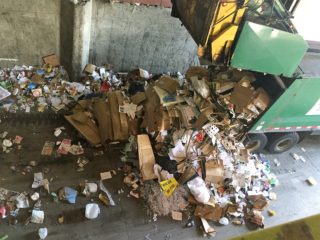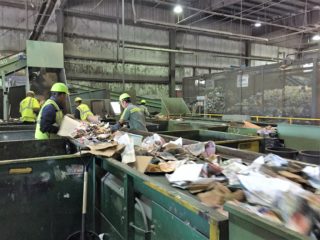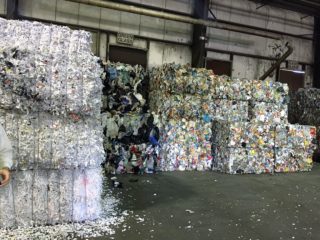Recently, a group from the University of Rochester had the opportunity the visit the Monroe County Recycling Center. The group was from the Waste Minimization Steering Committee whose mission is, “To be a leader in cost effective management practices to reduce, repurpose, and reuse waste materials through innovation, education, and community based programs.” Membership includes representatives from River Campus Facilities Operations, Medical Center Facilities Operations, Dining Services, Food and Nutrition Services, Corporate Purchasing, Horticulture and Grounds, and Wastes Management. The group meets quarterly to review standard agenda items, share information, and look for new waste reduction opportunities. Also included in each quarterly meeting is a presentation on a special topic of choice. The meeting held last month included the tour as its special topic so that the group can see what happens to the curbside recyclable items after they are placed in the recycle bin.
Recycling in Monroe County has evolved over time. In 1992, Monroe County passed a recycling law that requires all residents, businesses, industries and institutions to recycle. In 2004 the Monroe County Recycling Center (MCRC) accepted all clean paper, cardboard, aluminum and tin cans, and #1 and #2 plastic containers. In 2010, the MCRC expanded it’s collection and began accepting plastic containers numbered 1-7, as well as aluminum foil, foilware and household metal pots and pans. Traditionally, the MCRC operated under a dual stream collection system, meaning that all fiber (paper and cardboard) was kept separate from commingled plastic, metal and glass, and processed in two separate sorting systems. But in 2014, 3.5 million dollars was invested on new equipment and technology to implement a single stream recycling system. Single stream means that paper materials no longer need to be separated from commingled material and can mixed together. Click here for a list of what is acceptable at this facility.
Below are some pictures of the sorting system, which is largely intended for residential customers. Magnets are used to separate metal items, air is used to separate paper and smaller items, and plastics are largely separated by hand. While the previous sentence is a gross oversimplification of the whole operation, the much more complex system is undoubtedly really fascinating to see in person! A special thank you to Waste Management for hosting the tour for our group. Watch the video below for a tour of a similar facility in Philadelphia.





